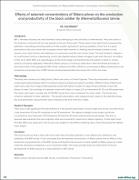| dc.contributor.author | Khainza, Jane | |
| dc.date.accessioned | 2023-06-02T11:38:51Z | |
| dc.date.available | 2023-06-02T11:38:51Z | |
| dc.date.issued | 2023-03 | |
| dc.identifier.other | Book of Abstracts - https://ea-agroecologyconference.org/wp-content/uploads/2023/05/Boook-of-Abstracts-3-digital.pdf | |
| dc.identifier.uri | http://hdl.handle.net/20.500.12280/3023 | |
| dc.description.abstract | Introduction- BSF ( Hermetia illucens) are small harmless insects belonging to the sub family of Hermetiinae. They are native to
the American continent but has now spread to the rest of the world. These insects have been found to possess the
potential in providing promising solutions to the modern agriculture’s growing problems. Much as it is a good
alternative to the use of silver fish as protein animal feed however it’s feeding had remained a threat to food
security since most farmers were feeding it on maize bran and left over human foods. This had limited it’s adoption
by local farmers living in a developing country like Uganda whose citizens struggle to get what they eat. According
to Paz et at., 2015, BSFL are saprophogous at the larval stage and therefore have the ability to feed on various
products including vegetables. Meanwhile Bidens pilosa is a notorious weed which when fermented provided an
alternative feed to the saprophytic BSF larvae. However the effect different concentrations Bidens pilosa had on the
production and productivity of BSF larvae remained questionable thus hence the call for the study.
Methodology - The study was carried out in Mpigi district, Nkozi sub county in Central Uganda. The study employed a complete
randomised research design which involved an intensive analysis of research variables. Different ratios of feeds and
water were used, that is 3kgs of feed substrate mixed with 3litres of water (1:1), 3kgs of feed substrate mixed with
6litres of water (1:2) and 6kgs of substrate mixed with 3litres of water (2:1) as treatments R1, R3 and R2 respectively.
The study used used a sample size of 100 BSF larvae from every treatment for every week. The larvae were
randomly selected for data collection. The growth parameters were measured each week on the selected larvae,
the yield parameter measurements were collected at the end of the four weeks.
Results & Discussion - There was a high significant (P<0.05) difference in the growth parameters ( larvae length and larvae circumfer-ence)
in the treatments R3 and R1 compared to the R2 treatments. The highest average larvae length and larvae
circumference was observed in R3 followed by R1 and then R2 which had the least larvae length. This was so
because feed substrate that was originally solid was converted to liquid slurry before ingestion. A high signif-icant
(P<0.05) effect was observed in the larvae mass weight for the different feeding ratios where R3 showed the highest
mass weight.
Conclusion - The study found out that a ratio with more water than the feed substrate is more effective for attraction and
breeding of the BSF larvae. It was concluded that the selected concentration of Bidens pilosa had an effect on the
production and productivity of the BSF larvae and therefore the amount of water added to Bidens pilosa as a feed
substrate should be considered so as to maximize profits. This study provides base line information for future
development of Bidens pilosa as a feed substrate to BSF larvae. | en_US |
| dc.language.iso | en | en_US |
| dc.publisher | Ecological Organic Agriculture - Growing Sustainability | en_US |
| dc.relation.ispartofseries | 1st Eastern Africa Agroecology Conference;Transforming Food Systems for Responsible Production, Consumption and Social Wellbeing | |
| dc.subject | Bidens pilosa | en_US |
| dc.subject | Hermetia illucens | en_US |
| dc.subject | BSF larvae | en_US |
| dc.subject | Concentration | en_US |
| dc.subject | Production | en_US |
| dc.subject | Productivity | en_US |
| dc.title | Effects of selected concentrations of Bidens pilosa on the production and productivity of the black soldier fly (Hermetiaillucens) larvae | en_US |
| dc.type | Presentation | en_US |


